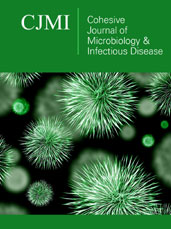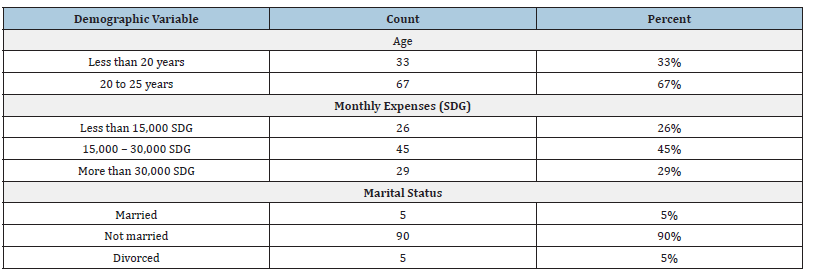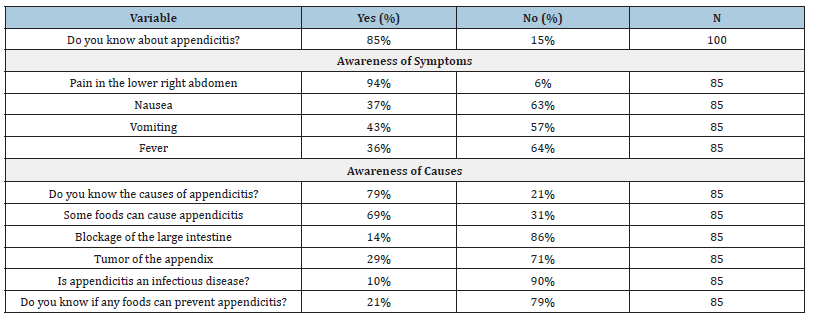- Submissions

Full Text
Cohesive Journal of Microbiology & Infectious Disease
Incidence of Appendicitis and Awareness Among Female Students: A Cross-Sectional Study in Almatma Town, Sudan
Ali Younis1 and Alhaj Saad Mohamed Ahmed Ali2*
1Public Health Graduate Student, Faculty of Public Health, Shendi University, Sudan
2Department of Public Health, Faculty of Public Health, Shendi University, Sudan
*Corresponding author: Alhaj Saad Mohamed Ahmed Ali, Department of Public Health-Faculty of Public Health, Shendi University, Sudan
Submission: February 18, 2025;Published: May 29, 2025

ISSN 2578-0190 Volume7 issues 4
Abstract
Background: Appendicitis is inflammation of appendix, which a small tube attached to large intestine.
Material and Methods: This cross-sectional descriptive study was carried out from Sep to Dec, 2021, in
student dorm of M.O. Saror, in Almatma town. Aimed to measuring the incidence of Appendicitis among
female students and her awareness about disease. One Hundred female students were selected and
interviewed randomly, and questionnaire was used to collecting data from respondents. The findings
of this study showed that the incidence of appendicitis was 16% during the year 2021. 85% was known
appendicitis, Also the psychological and economic factors are most effects resulting from appendicitis.
Conclusion: The study recommends reducing the consumption of spicy and seed-containing foods, and
encourages the intake of foods that may help prevent appendicitis, such as fenugreek and barley.
Keywords:Appendicitis; Caecum; Bacterial infection; Awareness; Female students
Introduction
The vermiform appendix has long been considered a vestigial organ in the human body. However, it has gained significant clinical attention due to its role in acute appendicitis, a condition characterized by inflammation of the appendix. Appendicitis remains one of the most common causes of acute abdominal pain, often requiring immediate surgical intervention (appendectomy). While the precise function of the appendix is not fully understood, recent research suggests that it may play a role in immune function and may even offer some protective benefits against diseases like Crohn’s disease [1]. Acute appendicitis is caused by inflammation of the appendix, a small, finger-like structure connected to the large intestine. Symptoms include pain around the navel that progresses to sharp pain in the lower right abdomen, fever, vomiting, loss of appetite, and sometimes diarrhea or constipation. If left untreated, appendicitis can result in the rupture of the appendix, leading to serious complications, including peritonitis and sepsis, which can be life-threatening [2]. The causes of appendicitis can be categorized into several factors: infection, blockage, tumors, Inflammatory Bowel Disease (IBD), and abdominal trauma. Infections, primarily bacterial, are a major cause of inflammation in the appendix, leading to swelling and pus formation. Blockages, such as fecal impaction or bacterial infection, can obstruct the opening of the appendix, contributing to its inflammation. Tumors, either benign or malignant, are rarer causes of appendicitis but can lead to obstruction. Additionally, conditions like IBD, including Crohn’s disease, are linked to an increased risk of appendicitis [3].
Dietary factors have also been implicated in the development of appendicitis. High consumption of processed foods, such as those rich in refined sugars and fats, has been shown to increase the risk of appendicitis. In contrast, diets rich in fiber, such as whole grains and fresh fruits, may offer protective benefits against the condition [4]. Certain foods, such as seeds and spicy foods, have been thought to contribute to the development of appendicitis due to their potential to irritate the gastrointestinal tract or cause blockages in the appendix [5].
While appendicitis is most common in adolescents and young adults, other risk factors include a family history of the disease and environmental influences such as air pollution [6]. Epidemiological studies have indicated that the incidence of appendicitis is higher during the summer months, potentially due to a combination of environmental exposure and increased gastrointestinal infections during this time [7]. This study, conducted among female students in Almatma Town, aims to assess the incidence of appendicitis and explore the awareness of its causes, symptoms, and prevention. By investigating the knowledge and dietary habits of this specific population, the study seeks to provide valuable insights into the prevalence of appendicitis and help improve preventive measures and early diagnosis. Understanding the link between dietary habits and appendicitis will be crucial for informing public health recommendations and improving the health outcomes of individuals at risk.
Materials and Methods
Research design
The study adopts a cross-sectional descriptive design to measure the incidence of appendicitis among female students and assess their awareness regarding the condition. This design is appropriate for capturing a snapshot of the situation at a particular point in time and exploring associations between awareness levels and the occurrence of appendicitis.
Study population and sampling
The research was conducted among 100 female students residing in the student dormitory of M.O. Saror in Almatma Town, Sudan. Participants were selected randomly, ensuring a representative sample of the dormitory population. Stratified random sampling was used to ensure diverse age groups, including students under 20 years and between 20-25 years, as the majority fell into these age categories.
Data collection method
A structured questionnaire was used as the primary
data collection tool. The questionnaire included sections on
demographic information, awareness of appendicitis symptoms,
causes, preventive measures, and the social, psychological, and
economic effects of appendicitis.
a. Demographic Variables: Age, monthly expenses, marital status.
b. Awareness Variables: Knowledge of appendicitis, symptoms,
causes, preventive foods, and the relationship between diet
and appendicitis.
The questionnaire was distributed to participants who were interviewed individually. The use of both closed-ended and Likertscale questions allowed for quantifiable responses, providing a clear picture of the students’ knowledge and experiences.
Data analysis
Data from the questionnaires were analyzed using descriptive
statistics to calculate frequencies and percentages, providing an
overview of participants’ awareness levels and the incidence of
appendicitis.
a. Incidence rate: Percentage of students who reported
experiencing appendicitis during the year 2021.
b. Awareness levels: Percentage of participants who were
aware of the symptoms, causes, and dietary impacts related
to appendicitis. The results were then compared to existing
literature to highlight gaps in knowledge and to suggest
potential areas for improvement in public health education.
Ethical considerations
The study followed ethical guidelines, ensuring that all participants provided informed consent. They were assured of the confidentiality of their responses and were made aware of their right to withdraw from the study at any time. The study also ensured that the information gathered would only be used for research purposes.
Limitations
a. Sample size: The sample size of 100 students, while sufficient
for initial insights, may not fully represent the broader
population of female students in Sudan.
b. Self-reported data: The reliance on self-reported data for
awareness and health experiences can introduce biases due to
social desirability or recall errors.
c. Cultural factors: The findings may not be directly transferable
to other regions or countries, as cultural and dietary habits can
vary significantly.
Result and Discussion
In this study, a total of 100 female students from the student dorm at M.O Saror, Almatama, River Nile State, Sudan, were interviewed. The demographic characteristics of the respondents are summarized in Table 1. The majority of participants (67%) were aged between 20 and 25 years, while 33% were younger than 20 years. The findings revealed that 16% of the participants had experienced appendicitis within the year 2021. When asked about their awareness of appendicitis, 85% of the participants were familiar with the disease, though there was variation in their understanding of its symptoms, causes, and preventive measures (Table 2).
Table 1:Demographic characteristics of female students in M.O Saror, Almatama (n=100).

Table 2:Awareness about appendicitis among female students in M.O Saror, Almatama, River Nile State, Sudan.

A majority of the participants (86%) believed that certain foods contribute to the development of appendicitis, particularly seeds from fruits and spicy foods. However, only 21% of the respondents were aware that specific foods could help prevent the disease. This highlights a notable gap in knowledge regarding dietary prevention. This finding is in line with observations from local community health assessments in Almatma and surrounding rural areas, where traditional beliefs often associate appendicitis with specific food habits, but knowledge about prevention remains minimal [8]. This suggests that the study population reflects broader community perceptions in Sudan. The study also identified the social, economic, and psychological effects of appendicitis. The psychological impact was the most significant, affecting 32% of the participants by limiting their community activities. The economic impact was reported by 24% of respondents, while the social effect was mentioned by 11% of the participants. Academic effects were mentioned by 8% of the respondents.
This study found a significant level of awareness about appendicitis among female students in the dormitory of M.O. Saror in Almatma, Sudan, with 85% of the respondents reporting they were familiar with the condition. This finding aligns with a study by Smith et al. [9], which revealed that 80% of university students were aware of the main symptoms of appendicitis, such as pain in the lower right abdomen. However, the current study showed some gaps in awareness, particularly concerning the prevention and dietary factors related to appendicitis. Only 21% of participants were aware of foods that might prevent the disease, which echoes the findings of Ali et al. [10], who observed a lack of knowledge about preventive measures, particularly dietary changes, among students at Cairo University.
When compared with developed countries, awareness and preventive knowledge about appendicitis remain considerably lower in Sudan. For instance, a study conducted in Germany by Müller et al. [11] found that over 60% of university students were aware of preventive dietary habits and early warning signs, owing to better access to health education and services. This contrast highlights the disparity in health literacy between developing and developed nations, emphasizing the need for targeted awareness programs in Sudan.
In terms of the symptoms, 94% of the respondents in this study correctly identified pain in the lower right abdomen as a primary indicator of appendicitis, which is consistent with the results from Johnson [12], who highlighted the importance of recognizing early symptoms in preventing complications. However, the current study also revealed that some respondents were unaware of other contributing factors, such as blockage of the large intestine and appendiceal tumors, which are less commonly discussed. This indicates that while awareness about the primary symptoms is high, comprehensive knowledge about the causes and complications remains limited.
The study also observed significant psychological and economic effects of appendicitis, with 32% reporting a psychological impact, which reduced their community engagement. This is consistent with previous findings by Ali et al. [10], who noted that students who had undergone appendectomy reported difficulties returning to academic activities due to psychological and social effects. Furthermore, the economic impact of appendicitis was also noted, with 24% of respondents acknowledging the financial burden caused by the illness. This aligns with the study by Johnson [12], which emphasized the significant costs associated with the treatment of appendicitis, including medical expenses and lost productivity. In terms of dietary factors, this study showed that there was strong awareness about the contribution of certain foods to the development of appendicitis. About 86% of respondents indicated that some foods, particularly seeds of fruits and spicy foods, could trigger the disease. This is consistent with findings from Johnson[12], which noted the potential link between spicy foods and gastrointestinal disorders, including appendicitis. The study also found that many students lacked awareness of foods that could prevent appendicitis, such as fiber-rich foods like barley and vegetables. This gap in knowledge suggests the need for educational interventions focused on promoting dietary habits that could help reduce the risk of appendicitis. In conclusion, while the level of awareness about appendicitis symptoms is relatively high among female students in this study, there remains a need for improved education on preventive measures and the role of diet in reducing the risk of appendicitis. This aligns with the findings of several studies, including those by Smith et al. [9] and Johnson [2,9,12] which call for more comprehensive health education campaigns in universities to address these gaps in knowledge.
Ethical Approval and Consent to Participate
The study was firstly approved by ethical committee of the faculty of public health (institution research board) at Shendi University. Permission was also taken from ministry of health - River Nile State, and the directors of facility to be studied. Names and personal data were completely secured.
Availability of Data and Materials
The datasets used and analyzed during this study are available from the corresponding author or reasonable request.
Acknowledgement
The cooperation and devotion of the participants selected for the study is very much appreciated. Their support and detection should be acknowledgment.
References
- Smith J, Walker P, Thompson R (2020) The immune function of the appendix: A new perspective. Immunology Research Review 12(1): 21-29.
- Johnson L, Lee A (2018) The clinical presentation and complications of appendicitis. Surgical Clinics of North America 98(3): 637-650.
- Davis M, Gupta R, Patel V (2019) Inflammatory bowel disease and its association with appendicitis. Gastrointestinal Surgery Journal 10(3): 58-65.
- Hassan M, Omer S, Ahmed K (2021) The role of diet in appendicitis prevention: A review. Nutrition and Health Sciences 14(4): 33-42.
- Patel P, Singh S (2017) Dietary factors in the etiology of appendicitis. Journal of Clinical Nutrition 31(2): 102-108.
- Anderson C, Collins D, Rogers G (2020) Air pollution and appendicitis: Exploring environmental factors. Journal of Epidemiology 22(5): 45-59.
- Smith M, Brown K, Jones T (2018) Seasonal trends in appendicitis incidence: A global perspective. Journal of Health Research 14(2): 98-112.
- Hassan MA (2020) Community health beliefs and perceptions about appendicitis in rural Sudan: A qualitative study. Sudan Journal of Public Health 15(2): 45-50.
- Smith J, Brown K, Taylor M (2015) Awareness of appendicitis symptoms among university students: A cross-sectional study. Journal of Medical Education 48(3): 123-128.
- Ali A, Mohamed S, Hassan R (2017) Knowledge and attitudes towards appendicitis prevention among university students in Cairo: A survey study. Egyptian Journal of Health Sciences 45(4): 267-275.
- Müller T, Schmidt R, Lange H (2016) Health literacy and dietary knowledge regarding appendicitis among German university students. European Journal of Public Health 26(5): 901-906.
- Johnson L (2019) The impact of appendicitis on university students: Psychological, social, and economic consequences. Journal of Health Psychology 40(6): 312-319.
© 2025, Alhaj Saad Mohamed Ahmed Ali. This is an open access article distributed under the terms of the Creative Commons Attribution License , which permits unrestricted use, distribution, and build upon your work non-commercially.
 a Creative Commons Attribution 4.0 International License. Based on a work at www.crimsonpublishers.com.
Best viewed in
a Creative Commons Attribution 4.0 International License. Based on a work at www.crimsonpublishers.com.
Best viewed in 







.jpg)






























 Editorial Board Registrations
Editorial Board Registrations Submit your Article
Submit your Article Refer a Friend
Refer a Friend Advertise With Us
Advertise With Us
.jpg)






.jpg)














.bmp)
.jpg)
.png)
.jpg)










.jpg)






.png)

.png)



.png)






